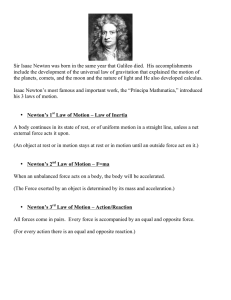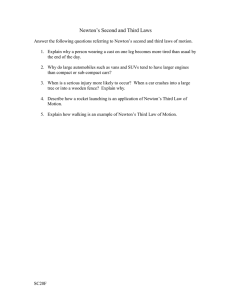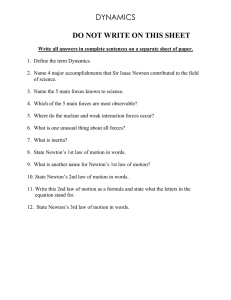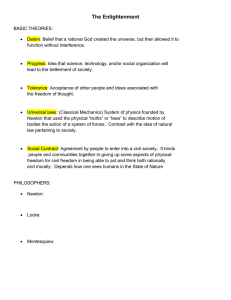Ch. 5: Newton’s Laws of Motion DYNAMICS
advertisement
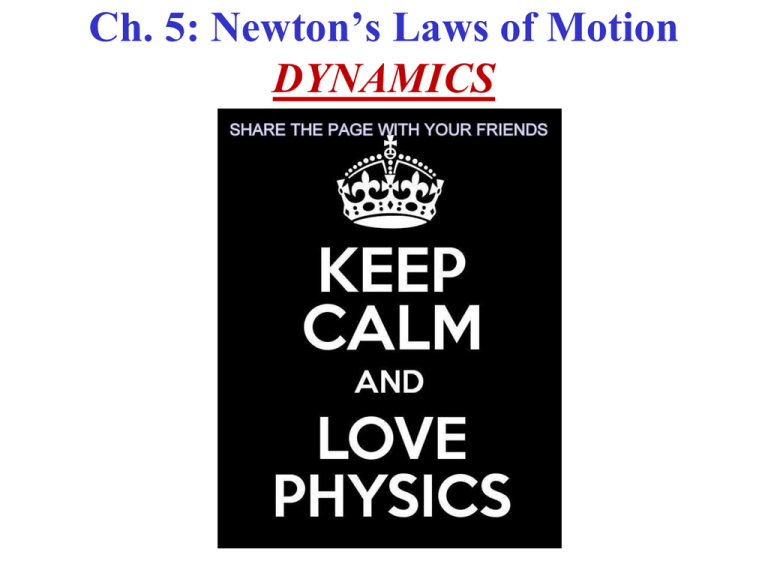
Ch. 5: Newton’s Laws of Motion DYNAMICS Force Force: “A push or a pull”. F is a VECTOR! Vector Addition is needed vector to add Forces! Examples of Forces “Contact” Forces “Field” Forces “Pulling” Forces (Physics II): “Pushing” Force Classes of Forces • Contact forces involve physical contact between two objects – Examples (in pictures): spring force, pulling force, pushing force • Field forces act through empty space. – No physical contact is required. – Examples (in pictures): gravitation, electrostatic, magnetic Measurement of Forces: Spring Scale Vector addition to add Forces! Fundamental Forces of Nature • Gravitational Forces – Between objects • Electromagnetic Forces – Between electric charges • Nuclear Weak Forces – Arise in certain radioactive decay processes • Nuclear Strong Forces – Between subatomic particles Note: These are all field forces! The 4 Fundamental Forces of Nature The Sources of these forces: In order of decreasing strength • Strong Nuclear Force: – Binds nuclei together. Still being researched. • Electromagnetic Force: – E&M phenomena. Chemical forces. Most everyday forces. Maxwell, Coulomb, Ampere, Faraday, ... • Weak Nuclear Force: – Nuclear decay. Fermi, Bethe & others. Still being researched. • Gravitational Force: – Newton (“classical” mechanics) – Einstein (general relativity) The 4 Fundamental Forces of Nature The Sources of these forces: In order of decreasing strength The 4 Fundamental Forces of Nature • “Electro-Weak” Force: – Since ~ the late 1960’s, in some sense have reduced the 4 fundamental forces to 3! – The Electromagnetic Force & the Weak Nuclear Force were combined into one theory. – S. Weinberg & A. Salaam: The 1972 Nobel Prize in Physics! Sir Isaac Newton • 1642 – 1727 • Formulated the Basic Laws of Mechanics • Discovered the Law of Universal Gravitation • Invented a form of Calculus • Made many observations dealing with Light and Optics Newton’s Laws of Motion • The ancient (& wrong!) view (of Artistotle): A common – Need a force to keep an object in motion. MISCONCEPTION – The “natural” state of an object is at rest. in the 21st Century! • The CORRECT VIEW (of Galileo & Newton): – It’s just as natural for an object to be in motion at constant speed in a straight line as to be at rest. Proven by Galileo – At first, imagine the case of NO FRICTION in the 1620’s! – Experiment: If NO FORCE is applied to an object moving at a constant speed in straight line, it will continue moving at the same speed in a straight line! If I succeed in having you overcome the wrong ancient misconception & understand the correct view of this, A MAJOR GOAL of the COURSE WILL HAVE BEEN ACHIEVED! Reference Frames Inertial Reference Frame (As defined by Newton) ≡ A reference frame (coordinate system) which is moving with constant velocity (no acceleration!) with respect to the “fixed stars”. – Clearly, an idealization! Rigorously, Newton’s Laws are ONLY valid in an Inertial Reference Frame Newton’s Laws • Galileo laid the ground work for Newton’s Laws. Galileo Galilei in middle age • Newton: Built on Galileo’s work • Newton’s 3 Laws: One at a time Sir Isaac Newton as a young man Newton’s First Law • 1st Law: (“Law of Inertia”): “In the absence of external forces and when viewed from an inertial reference frame, an object at rest remains at rest and an object in motion remains in motion with a constant velocity (constant speed in a straight line).” Sir Isaac Newton as an older man Newton was born the same year Galileo died! • Newton’s 1st Law: (Alternate Language): 1. “When no net force (∑F = 0) acts on an object, the acceleration of the object is zero.” ∑ = a math symbol meaning sum (capital sigma) 2. “If an object does not interact with other objects, it is always possible to identify a reference frame (an inertial frame) in which the object has zero acceleration.” • From the 1st Law: Can define a Force as “An action which causes a change in the motion of an object.” • Newton’s 1st Law: First stated by Galileo! Newton’s First Law A Mathematical Statement of Newton’s 1st Law: If v = constant, ∑F = 0 OR if v ≠ constant, ∑F ≠ 0 Conceptual Example Newton’s First Law A school bus comes to a sudden stop, and all of the backpacks on the floor start to slide forward. What force causes them to do that? Newton’s First Law Alternative Statement • In the absence of external forces, when viewed from an inertial reference frame, an object at rest remains at rest & an object in motion continues in motion with a constant velocity. – Newton’s 1st Law describes what happens in the absence of a net force. – It also tells us that when no force acts on an object, the acceleration of the object is zero.
